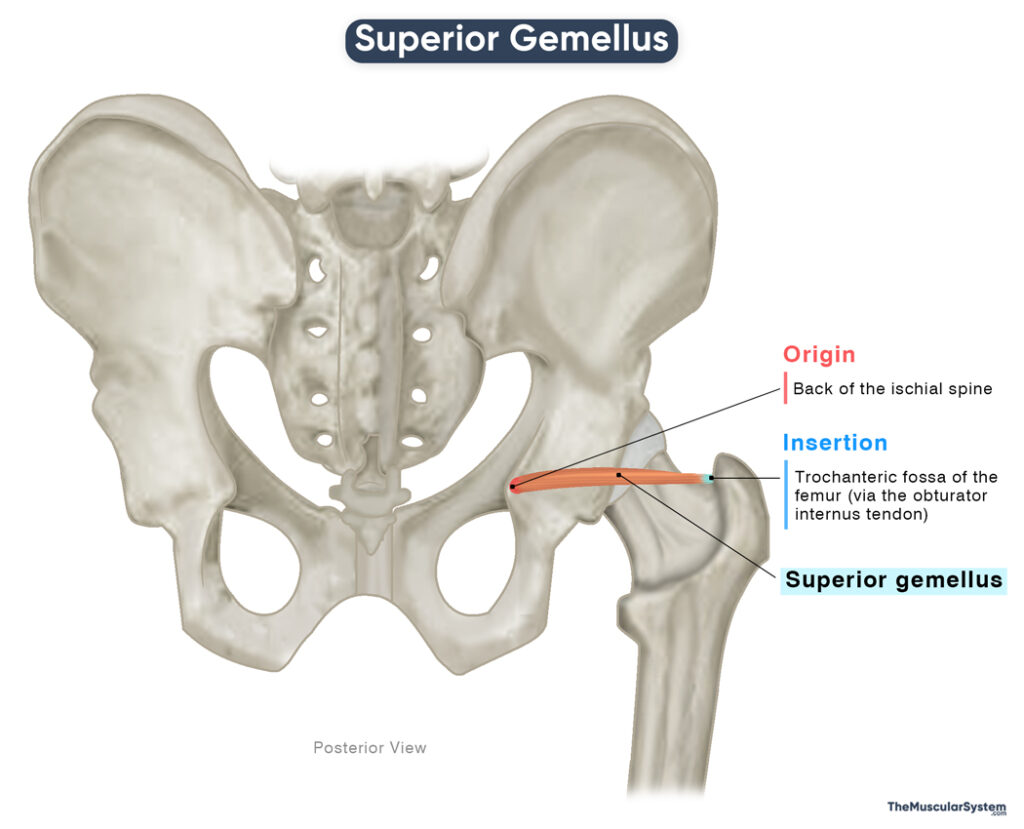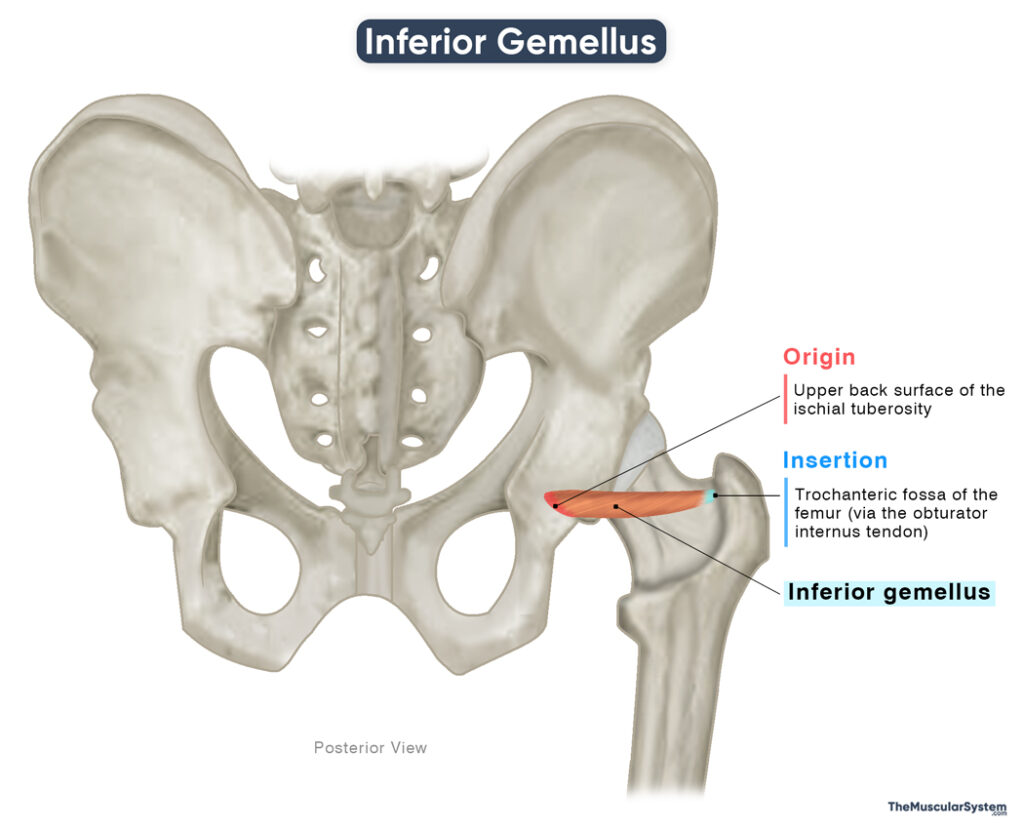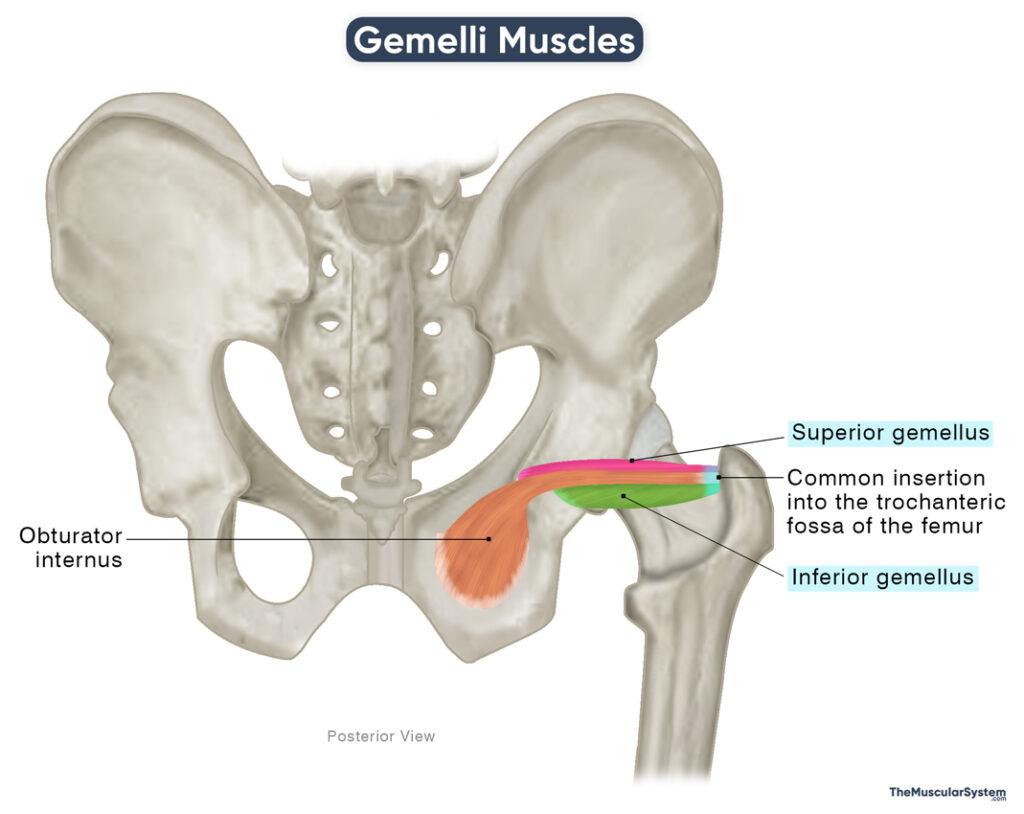Gemelli Muscles
Last updated:
17/07/2025Della Barnes, an MS Anatomy graduate, blends medical research with accessible writing, simplifying complex anatomy for a better understanding and appreciation of human anatomy.
The gemelli muscles are a pair of small, deep muscles located in the gluteal region. They are named according to their positions: the superiorly located muscle is called the superior gemellus, and the inferiorly located one is the inferior gemellus.
The name gemellus comes from Latin, meaning “twin,” referring to the two muscles’ similar size, shape, and function.
The gemelli are part of the lateral rotators of the thigh, working alongside the obturator muscles, piriformis, and quadratus femoris to externally rotate the femur at the hip joint.
Anatomy
Location and Attachments
The muscles originate from different parts of the ischium bone, but share the same point of insertion.
| Muscle | Origin | Insertion |
| Superior Gemellus | Back of the ischial spine | Trochanteric fossa of the femur via the inserting tendon of the obturator internus |
| Inferior Gemellus | Upper back of the ischial tuberosity | Same as superior gemellus |
Origin
The superior gemellus originates as a broad sheet of fibers from the posterior surface of the ischial spine, one of the two narrow bony projections on the posterior aspect of the ischium.
The inferior gemellus has a similar broad origin, arising from the posterior surface of the upper part of the ischial tuberosity.
Insertion
From their origins, both gemelli muscle bellies run horizontally and laterally toward the hip joint, accompanying the tendon of the obturator internus as it bends through the lesser sciatic foramen. The fibers of the gemelli converge into narrow tendons, which blend with the tendon of the obturator internus — the superior gemellus joining it from above, and the inferior gemellus from below.
This common tendon inserts on the medial surface of the greater trochanter of the femur, at the trochanteric fossa.
Relations With Surrounding Muscles and Structures
On the Proximal Side
Superior Gemellus
The superior gemellus is the smaller of the two gemellus muscles. Proximally, it lies just below the piriformis muscle and above the obturator internus and inferior gemellus. Its posterior surface is covered by the gluteus maximus, which lies superficially, while the hip joint lies deep and anterior to it.
Several major nerves and blood vessels pass through the greater sciatic foramen in the interval between the piriformis and the superior gemellus. These include the sciatic nerve, the inferior gluteal nerve and vessels, the posterior femoral cutaneous nerve, and the pudendal nerve with internal pudendal vessels. They pass posterior to the superior gemellus and obturator internus tendons, between them and the gluteus maximus, as they travel toward the thigh or curve around to reach the perineum.
Inferior Gemellus
Slightly larger than the superior gemellus, this muscle lies between the obturator internus above and the quadratus femoris below. Like its superior counterpart, the inferior gemellus is covered posteriorly by the gluteus maximus, with the hip joint lying anterior to it.
The nerve to quadratus femoris courses deep to the inferior gemellus as it passes through the greater sciatic foramen.
On the Distal Side
Distally, the two muscles contribute to the triceps coxae, a three-headed muscle group formed by the tendons of the two gemelli and the obturator internus.
Function
| Action | Rotating the thigh laterally, and helping with thigh abduction when the hip is flexed |
The superior and inferior gemelli are often considered accessory muscles to the obturator internus and do not have independent functions. Instead, as components of the lateral rotator group and the triceps coxae, they assist in the following actions:
Rotating the thigh externally: External rotation of the thigh: Acting with the obturator internus and other lateral rotators, the gemelli muscles help rotate the extended thigh outward at the hip joint. For example, when pivoting the leg to turn sideways.
Abducting the thigh: Together with the obturator internus, they assist in abducting the thigh, which means moving the thigh away from the midline when the hip is flexed. For example, when sliding the leg outward to step out of a car.
Stabilizing the hip joint: By attaching to the femur and pulling the femoral head into the acetabulum, the gemelli contribute to stabilizing the hip joint during movement.
Antagonists
As members of the lateral rotator group, the actions of the gemelli are opposed by the medial rotators of the thigh, including the gluteus medius, gluteus minimus, and tensor fasciae latae.
Innervation
| Muscle | Nerve |
| Superior gemellus | Nerve to obturator internus (L5-S2) |
| Inferior gemellus | Nerve to quadratus femoris (L5-S1) |
The superior gemellus is innervated by a branch of the nerve to obturator internus, which arises from the anterior divisions of the L5, S1, and S2 spinal nerves in the sacral plexus. After supplying this muscle, the nerve continues to innervate the obturator internus.
The inferior gemellus is supplied by the nerve to quadratus femoris, which arises from the anterior divisions of the L4, L5, and S1 spinal nerves in the sacral plexus. This nerve gives a branch to the inferior gemellus before innervating the quadratus femoris and the hip joint capsule.
Blood Supply
| Artery (both muscles) | Inferior gluteal artery |
The primary blood supply to both the gemelli muscles comes from the inferior gluteal artery, with secondary contributions from the internal pudendal artery, both branching from the internal iliac artery.
References
- Gemelli Muscles: TeachMeAnatomy.info
- Anatomy, Bony Pelvis and Lower Limb, Gemelli Muscles: NCBI.NLM.NIH.gov
- Superior Gemellus Muscle: Radiopaedia.org
- Superior Gemellus Muscle: Kenhub.com
- Superior Gemellus Muscle: Elsevier.com
- Inferior Gemellus Muscle: Kenhub.com
- Inferior Gemellus Muscle: Elsevier.com
- Inferior Gemellus Muscle: IMAIOS.com
Della Barnes, an MS Anatomy graduate, blends medical research with accessible writing, simplifying complex anatomy for a better understanding and appreciation of human anatomy.
- Latest Posts by Della Barnes, MS Anatomy
-
Laryngeal Muscles
- -
Thyroarytenoid
- -
Lateral Cricoarytenoid
- All Posts








